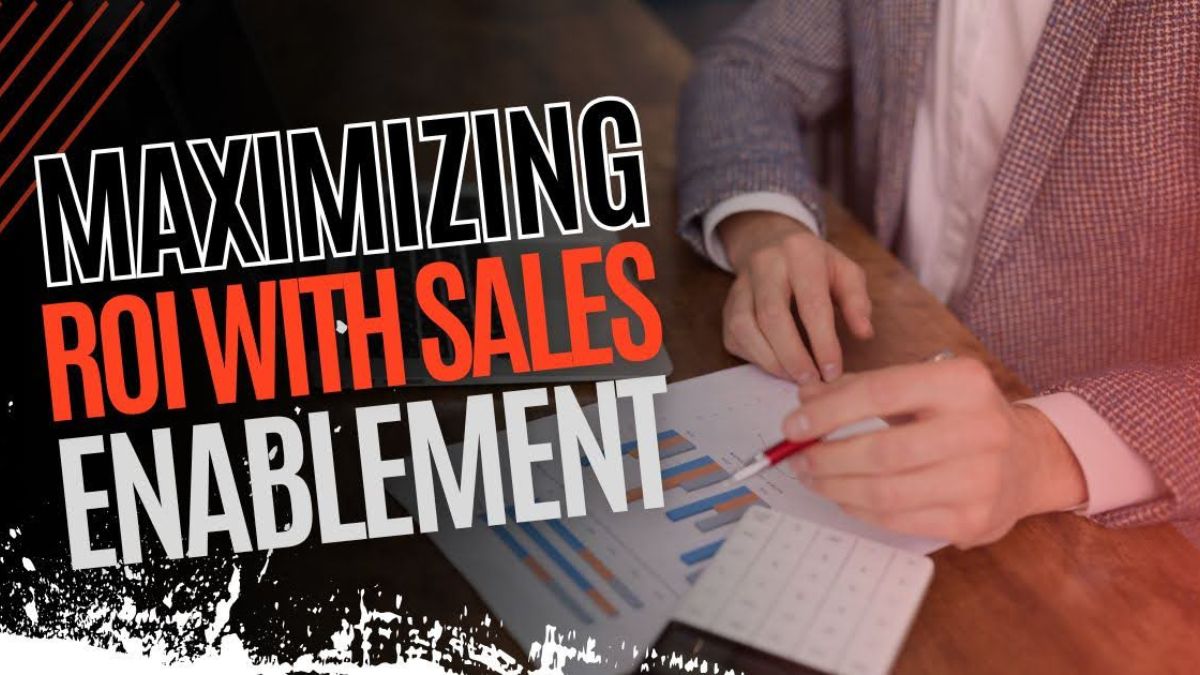TOPIC
Maximizing ROI with Sales Enablement: How Tools Drive Revenue Growth

How long have you been sticking with the same sales strategies? The business landscape has changed dramatically, and traditional sales approaches no longer guarantee success. The shift to virtual and hybrid selling models has redefined how businesses engage with prospects. To remain competitive, companies must prioritize ROI-driven sales enablement strategies that boost efficiency, accelerate revenue growth, and maximize sales performance.
Sales enablement is not just about providing tools—it’s a critical investment in business success. A well-implemented sales enablement strategy increases win rates, shortens sales cycles, and ensures every dollar spent yields tangible results. But how can you ensure your enablement initiatives deliver a high return on investment (ROI)?
Understanding Sales Enablement ROI
Sales enablement tools are technology solutions designed to maximize revenue potential by streamlining access to sales content, training, and performance analytics. These tools provide sales reps with real-time insights, automated workflows, and data-driven strategies, allowing them to close deals more efficiently and effectively. ROI in sales enablement is measured by its impact on productivity, revenue growth, and cost savings.
At their core, these tools align sales, marketing, and customer success teams to ensure a seamless and consistent buyer experience. By centralizing resources and automating processes, businesses reduce operational inefficiencies, lower acquisition costs, and improve overall sales performance.
Common Sales Challenges Impacting ROI
Global sales teams face several roadblocks that hinder revenue growth. Addressing these challenges through sales enablement tools is key to improving ROI.
- Slow onboarding and training: Lengthy ramp-up times reduce productivity and delay revenue generation.
- Inconsistent messaging: Misaligned communication between sales and marketing leads to lost opportunities.
- Inefficient sales processes: Reps spend too much time searching for materials instead of selling.
- Data blind spots: Lack of visibility into sales performance prevents informed decision-making.
- Adaptation to market changes: Sales teams struggle to keep up with shifting buyer preferences and competitive landscapes.
How Sales Enablement Tools Drive ROI
Faster Onboarding and Increased Productivity
Sales enablement tools significantly reduce the time for new hires to become fully operational. Automated training programs and interactive learning modules allow reps to learn at their own pace, reducing training costs and accelerating time-to-productivity. Businesses experience higher rep retention and faster deal closures with a structured onboarding process.
Improved Sales Effectiveness and Higher Win Rates
Providing sales reps with real-time, data-backed insights ensures they approach prospects with the right message at the right time. AI course creators analyze buyer behaviors and suggest tailored engagement strategies, leading to higher conversion rates and larger deal sizes.
Enhanced Alignment Between Sales and Marketing
A common challenge for revenue teams is misalignment in messaging and content accessibility. Sales enablement platforms centralize sales materials, pitch decks, and competitive insights, ensuring reps have the most relevant information at their fingertips. This alignment improves lead conversion and maximizes marketing ROI by increasing content utilization.
Increased Efficiency and Time Optimization
Sales reps spend up to 65% of their time on non-selling activities, such as searching for content or entering data manually. Enablement tools automate administrative tasks, freeing up more time for customer engagement. This increased efficiency directly impacts pipeline velocity and revenue growth.
Data-Driven Decision-Making for Continuous Improvement
Enablement platforms provide real-time analytics that tracks rep performance, content effectiveness, and customer engagement. Businesses can use these insights to optimize strategies, refine training, and implement targeted improvements that drive sustained revenue increases.
Best Practices for Maximizing ROI from Sales Enablement Tools
To ensure your sales enablement investment delivers maximum ROI, consider the following best practices:
- Define Clear KPIs: Establish measurable goals such as reduced onboarding time, increased deal sizes, and improved quota attainment.
- Ensure Cross-Department Collaboration: Engage sales, marketing, and leadership teams to foster alignment and enhance efficiency.
- Continuously Optimize Content and Training: Regularly update materials to reflect market trends and evolving buyer needs.
- Leverage Analytics for Strategic Adjustments: Use performance data to identify gaps, refine training, and tailor sales strategies.
- Choose Scalable, User-Friendly Technology: Select tools that integrate seamlessly with existing workflows and support global teams.
Boost Sales ROI with Arist
When sales enablement tools become revenue-generating assets rather than cost centers, they become revenue-generating assets rather than cost centers. Arist is at the forefront of this transformation, providing an intuitive, scalable platform designed to maximize ROI.
Why Choose Arist?
- Microlearning Redefined: Deliver bite-sized, impactful lessons via SMS, email, or chat platforms.
- Localized and Relevant Training: Ensure global teams receive customized content aligned with regional sales strategies.
- Rapid Deployment: Reduce training lag with fast, user-friendly implementation.
- Actionable Insights: Track engagement and performance metrics to continuously optimize sales strategies.
Investing in sales enablement isn’t just about supporting your team—it’s about maximizing revenue impact and ensuring long-term business success. Book a demo today to discover how Arist training can help you drive ROI and enhance sales performance.
TOPIC
What If a Motorcycle Defect Caused Your Crash?

Imagine riding your motorcycle, feeling the wind, when suddenly, disaster strikes. You crash. It’s terrifying and confusing. What if a defect in your motorcycle caused this tragedy? You need answers. A defective part could risk your safety more than you realize. You deserve to know the truth behind the accident and hold the right parties accountable. The journey to uncovering the cause starts with understanding what went wrong. Was it a faulty brake, ineffective steering, or a weak frame? Each could spell disaster. You must act swiftly to protect yourself and others. Learning who is responsible can empower you to prevent future harm. If you suspect a defect, it’s crucial to seek expert advice. Knowing where to turn is important. Inquire here for guidance on what steps to take next. Remember, taking action isn’t just about justice. It’s about safety and prevention.
Identifying the Defect
The first step in addressing a motorcycle defect is identifying the problem. Mechanical issues can range from minor to severe. Some common defects include brake failure, steering malfunctions, and structural weaknesses. These defects can result from manufacturing errors or design flaws. Recognizing a defect requires keen observation and sometimes expert assistance. If you notice unusual sounds, reduced performance, or if something feels off, you may be dealing with a defect.
Types of Common Motorcycle Defects
Understanding the types of defects helps in determining next steps. Below is a table summarizing common defects:
| Defect Type | Possible Consequences |
| Brake Failure | Increased stopping distance, collisions |
| Steering Malfunction | Loss of control, veering off-road |
| Structural Weakness | Frame collapse, severe injury |
Taking Action
Once you suspect a defect, action is necessary. Report the issue to the manufacturer and consult with a legal professional. It’s not just about getting compensation. It’s about preventing similar incidents. If you’re unsure how to proceed, resources are available. For more information on vehicle safety and defects, visit the National Highway Traffic Safety Administration website.
Legal Implications
Understanding the legal landscape is essential. If a defect caused your crash, you might have a case against the manufacturer or distributor. Lawsuits can be complex. They often require proving the defect and its direct link to the crash. Legal experts can guide you through this process. They help gather evidence and build a strong case.
Preventing Future Incidents
Prevention is crucial. Regular maintenance and inspections are key. Always check for recalls related to your motorcycle model. Keeping your motorcycle in top condition reduces the risk of defects. Educating yourself about potential risks empowers you to make informed decisions. It ensures your safety and the safety of others on the road.
Conclusion
A motorcycle accident caused by a defect is more than an unfortunate event. It’s a call to action. Recognizing defects, taking appropriate steps, and preventing future incidents are essential. Staying informed and proactive ensures safer rides for everyone. Remember, the road to safety starts with awareness and decisive action.
TOPIC
How Wildlife‑Related Crashes Affect Liability And Insurance Claims

Every year, wildlife causes thousands of accidents on our roads. These crashes can be distressing and lead to unexpected consequences. When you collide with an animal, you’re not just facing potential damage to your car. You might also deal with serious injuries and complex insurance claims. Understanding your liability in these situations is crucial. Insurance policies often vary, and knowing what to expect can help you navigate this tricky situation. You may wonder about coverage for repairs and medical costs. Or perhaps you’re concerned about how this affects your insurance rates. Each situation is different, and the details matter. Learn about your rights and responsibilities to protect yourself better. It’s essential to stay informed. As you drive, stay alert and watch the road. Discover more about how wildlife-related crashes impact your insurance claims and liabilities. Your awareness could make a significant difference in your life.
Understanding Wildlife-Related Crashes
Encountering wildlife on the road can be sudden and frightening. Animals like deer, moose, and even smaller animals pose significant risks. The damage can be extensive, affecting both your vehicle and your peace of mind. These incidents often happen during dawn and dusk when animals are most active. Avoiding such crashes requires vigilance and quick reactions. However, accidents still occur despite your best efforts.
Liability in Wildlife-Related Accidents
Determining liability in wildlife accidents is often complex. Generally, no one owns wild animals, so the responsibility doesn’t fall on a specific party. If you collide with wildlife, liability typically rests with the driver. This means you could be responsible for repair costs and potential increases in insurance premiums. Knowing what your insurance covers is essential. Comprehensive coverage often includes animal collisions, while liability insurance does not. Reviewing your policy details can prevent surprises later.
Insurance Claims: What to Expect
Filing an insurance claim after a wildlife crash can seem daunting. Knowing the steps to take can ease the process. First, ensure everyone’s safety and contact authorities if necessary. Document the incident with photos and notes about the conditions and time. Contact your insurance company promptly to report the accident. Each insurer may handle claims differently, so understanding your policy helps. Coverage for repairs, medical costs, and even towing depends on your insurance type.
Comparing Coverage Types
| Coverage Type | Includes Wildlife Collisions | Repair Costs Covered |
| Liability Insurance | No | No |
| Comprehensive Insurance | Yes | Yes |
| Collision Insurance | Sometimes | Depends on the provider |
This table shows how different coverage types handle wildlife collisions. Comprehensive insurance is your safest bet for full coverage in these scenarios. Always review your policy documents to understand your coverage scope.
Prevention and Safety Tips
Preventing wildlife crashes involves both awareness and action. Stay attentive, especially in areas with high animal activity. Use high beams when safe to spot animals earlier. Slowing down can give you more time to react. In areas with frequent wildlife crossings, be extra cautious. Whistles or devices claiming to deter animals are often ineffective. Instead, focus on driving carefully and maintaining control at all times. For more safety tips, visit National Highway Traffic Safety Administration.
The Role of the Community
Communities can play a part in reducing wildlife-related accidents. Local measures like installing signs or creating wildlife corridors can help. Educating drivers about high-risk areas and times is effective. Collaborating with local wildlife experts to understand animal patterns can also reduce incidents. Community effort is key to safer roads for everyone.
Conclusion
Wildlife-related crashes are unpredictable but manageable. By understanding your insurance policy and knowing your responsibilities, you can better handle these incidents. Prevention is key, but when accidents happen, being prepared helps. Ensure your policy covers potential wildlife encounters. Stay informed and cautious on the road. By taking these steps, you protect yourself and others. Drive safely and stay aware to minimize risks and enjoy peace of mind.
TOPIC
What To Do If A Drunk Driver Causes A Fatal Accident

A fatal accident involving a drunk driver shatters lives. If you face this tragedy, knowing your next steps is crucial. This guide helps you navigate these challenging moments. First, ensure your safety and others around you. Contact emergency services immediately. Authorities need to secure the scene and gather evidence. Then, reach out to family or friends for emotional support. The impact of such an event can be overwhelming. Seek professional legal advice promptly. Legal experts can help you understand your rights and options. Their assistance may be vital in ensuring justice for your loved one. Document everything you remember about the incident. Details can be essential later. Also, consider seeking counseling. Emotional recovery is as important as legal resolution. Addressing these steps eases the burden during this difficult time. Being prepared supports you in handling this tragic situation with strength and clarity. You are not alone in this journey.
Immediate Steps After the Accident
Once the scene is secure, focus on gathering information. Collect the names and contact numbers of witnesses. Take photos of the accident site if possible. These will aid in building your case. Understandably, emotions run high. However, clear documentation is crucial. Law enforcement will compile a report. Request a copy for your records. This report contains essential details. It will be crucial for legal and insurance purposes.
Legal Considerations
Engaging with the legal system can be daunting. Yet, it is an important step forward. Secure a reputable attorney experienced in dealing with drunk driving incidents. They will navigate the complexities of the law on your behalf. Start this process early. Legal procedures often require extensive time and effort. The attorney will help file claims and represent you in court if necessary.
Emotional and Psychological Support
Processing grief and trauma requires time and support. Many find comfort in speaking with counselors or support groups. There are professionals trained to help you through this difficult period. Friends and family members are also invaluable. Be open about your needs and feelings. They can offer a listening ear and necessary support.
| Support Option | Advantages | Disadvantages |
| Professional Counseling | Expert guidance, Confidential | Costly, Requires scheduling |
| Support Groups | Shared experiences, Community support | Availability varies, Less personalized |
| Family and Friends | Immediate availability, Emotional bond | May lack expertise, Emotionally invested |
Financial and Insurance Matters
Accidents lead to unexpected financial burdens. Insurance claims need to be filed promptly. Contact your insurance company to start the process. Provide them with the accident report and any additional information. It is also wise to consult with your legal advisor during this stage. They can ensure all documents are appropriately handled. In some cases, the process may lead to compensation. This can aid with medical or funeral expenses.
Long-Term Recovery and Resolution
Healing from this tragedy takes time. Some days will be harder than others. Establishing a routine can help restore a sense of normalcy. Engage in activities that bring you relief and comfort. Consider joining initiatives that advocate against drunk driving. Contributing to a cause may offer a sense of purpose.
Additional Resources
For more guidance, visit the National Highway Traffic Safety Administration (NHTSA). They offer resources on dealing with drunk driving incidents. You can also explore the Mothers Against Drunk Driving (MADD) website for support networks and advocacy opportunities.
Dealing with the aftermath of a drunk driving accident is a profound challenge. Each step taken brings you closer to resolution and healing. Reliable support and information make a significant difference. Remember, while the journey is difficult, you have resources and people ready to help. By taking active steps, you honor the memory of your loved one and contribute to a safer community.
-

 BLOG10 months ago
BLOG10 months agoIZoneMedia360 .Com: Exploring the Features and Benefits
-

 BLOG1 year ago
BLOG1 year agoAbout Blog TurboGeekOrg: A Go-To Hub for Tech Enthusiasts and Latest Innovations
-

 BLOG1 year ago
BLOG1 year agoWhat is a Golden Transit in Magi Astrology?
-

 NEWS9 months ago
NEWS9 months agoChloe Berger News: Insights on Employee Rights and Talent Retention
-

 BLOG10 months ago
BLOG10 months agoA Complete Guide to ProcurementNation.com Shipping
-

 ENTERTAINMENT1 year ago
ENTERTAINMENT1 year agoTyquaez Pickett: A Rising Star in the Entertainment World
-

 BLOG12 months ago
BLOG12 months agoWho Is Hall Sinclair? The True Story of Olivia Colman’s Son
-

 NEWS10 months ago
NEWS10 months agoThe Vision and Innovation of News Theamericansecretscom
